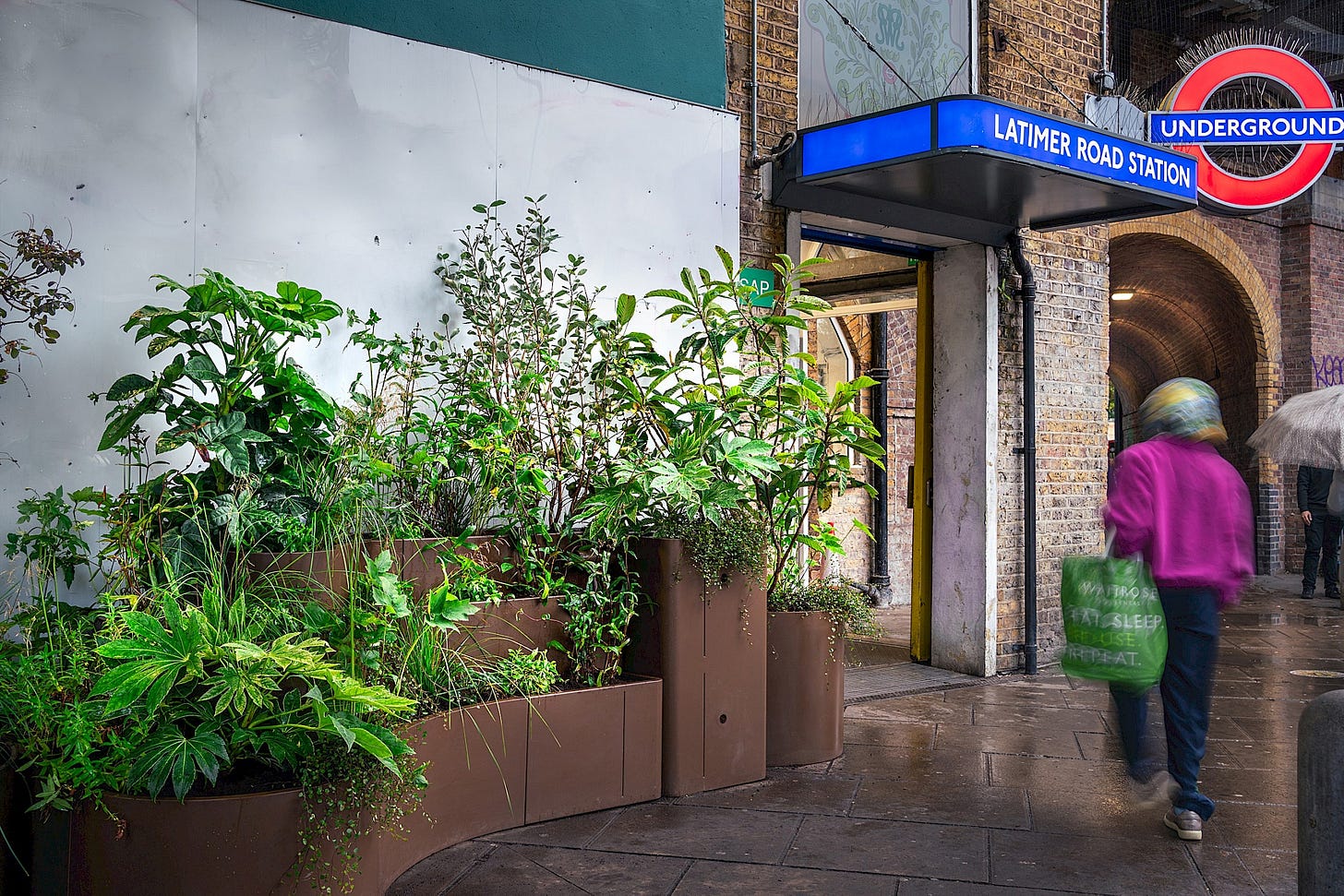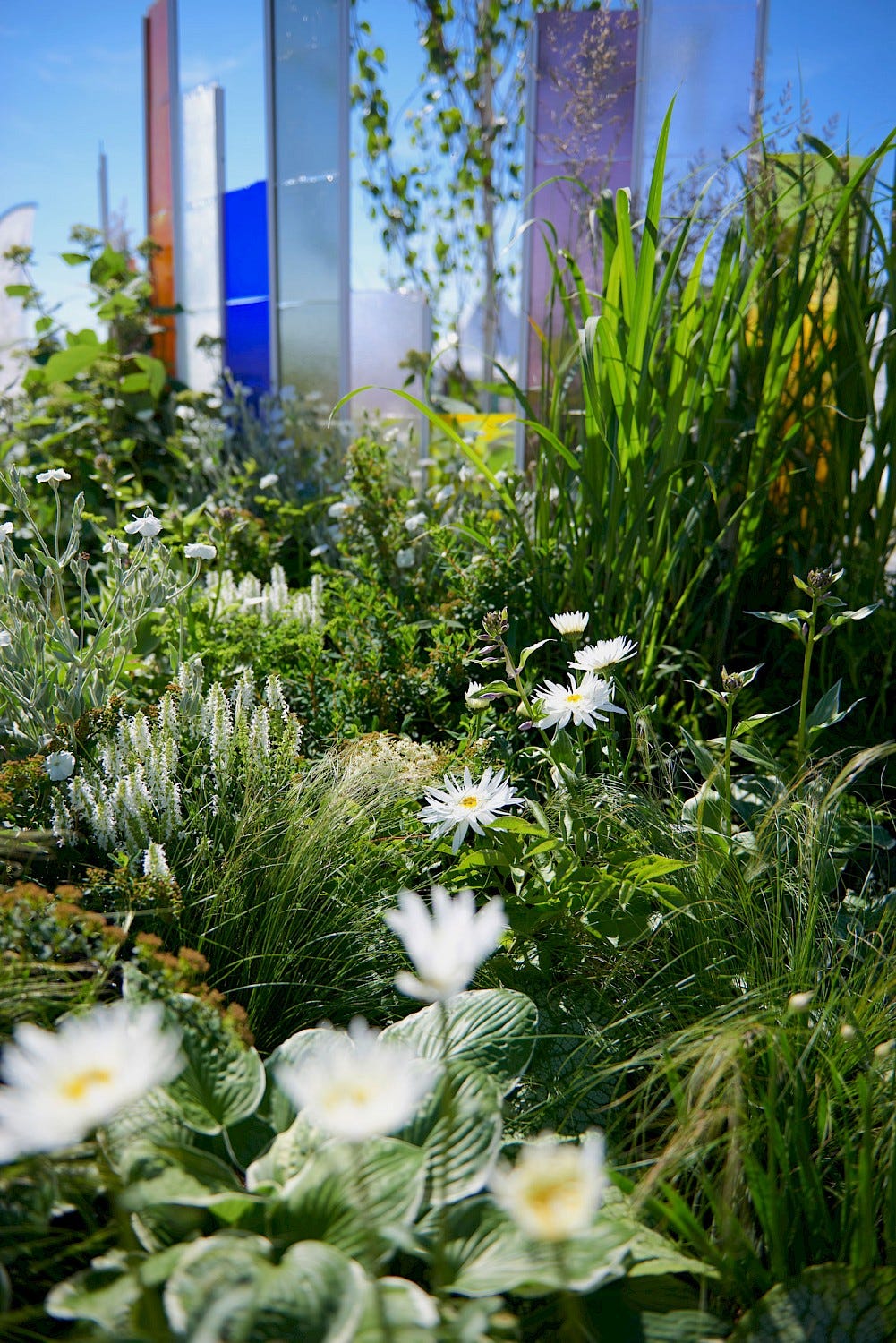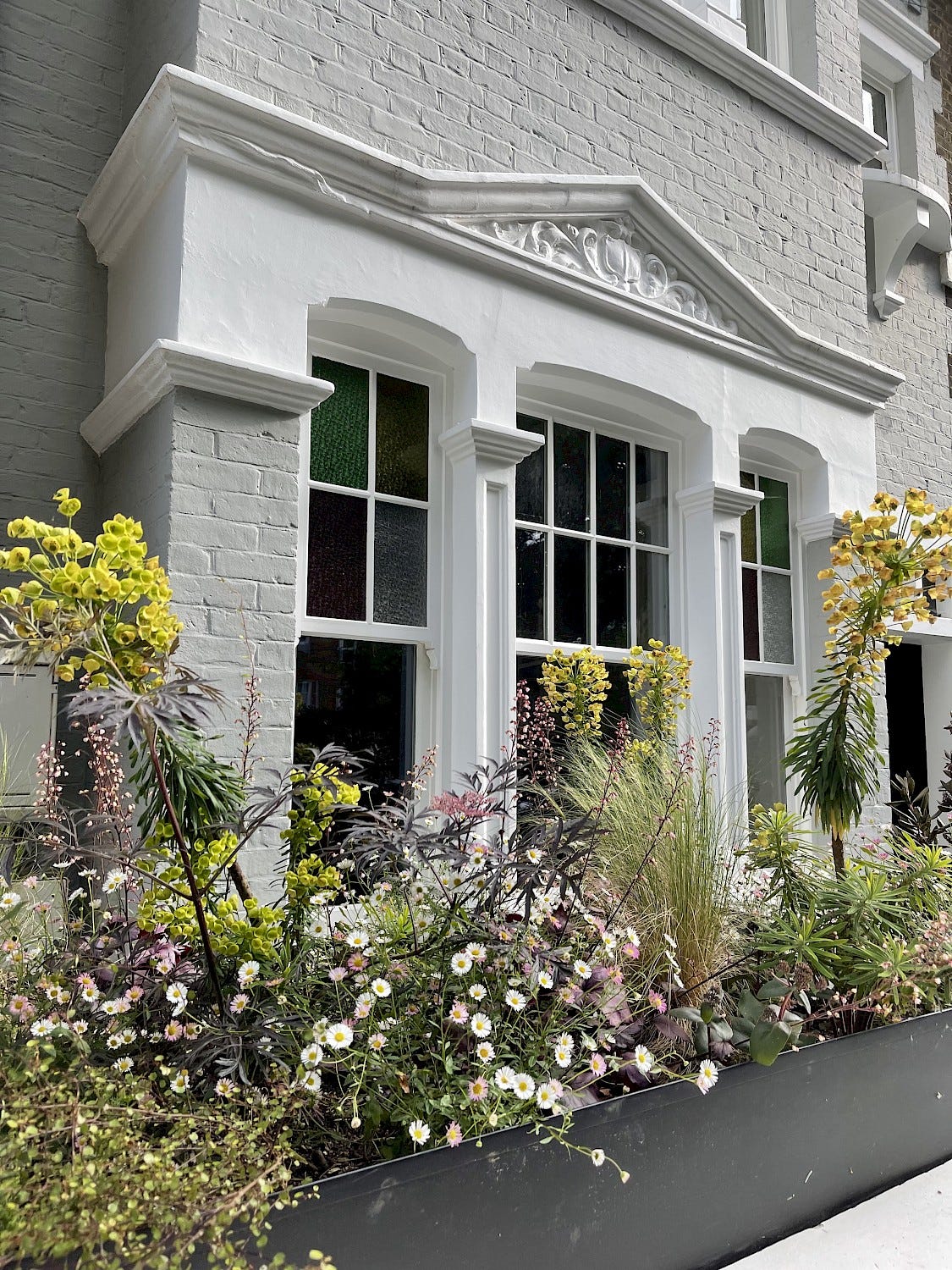Emilie Bausager: "I try to merge the contemporary and traditional"
London-born emerging young talent, now based in Copenhagen, transforms outdoor spaces into not just visually appealing landscapes but also environmentally conscious and socially inclusive hubs
👋
Dear friends and readers,
In this exclusive interview, I delved into the world of garden and landscape design with Emilie Bausager, an award-winning young talent whose work seamlessly blends contemporary aesthetics with timeless natural elements. Born in London and currently based in Copenhagen, Emilie draws inspiration from her mixed British and Danish heritage to create unique outdoor spaces that prioritize sustainability, biodiversity, and social inclusion.
I discovered Emilie’s work some time ago through Instagram, and since then, I have followed her work as a true fan inspired by her creative intelligence. Her perspectives on integrating technology into design and her vision for the future of outdoor landscapes are those of a genuine global leader.
I advise you to keep an eye on her from now on so you’ll be able to say,
"I already knew her."

Hello Emilie!
Thank you for joining me for this delightful conversation about the intersection of tech, nature, and design. To kick things off, could you introduce yourself to our readers and share a bit about your journey in the world of garden and landscape design?
Hi Eduardo!
I am Emilie Bausager, an award-winning garden designer and artist. Born in London and now residing in Copenhagen for the past decade, I draw inspiration from my mixed British and Danish heritage to craft distinctive outdoor spaces. My design ethos blends eclectic aesthetics inspired by historical influences with a Scandinavian commitment to sustainability and harmony with nature.
With a Bachelor's and Master's degree from the Royal Danish Academy of Arts, along with a diploma in Garden Design from the English Gardening School, I have cultivated a design studio that embraces a holistic approach to garden design. Integrating my creative background with practical considerations, I strive to create landscapes that seamlessly blend functionality with whimsical imagination. Since establishing my studio, I have collaborated with clients in both the UK and Denmark, dividing my time between the two countries. I have had the privilege of designing numerous show gardens and have been honored with multiple awards, including a recent gold medal at CPH Garden 2.

In the rapidly advancing landscape of technology, how do you weave modern tech into your designs, finding that sweet spot where innovation meets the serenity of nature?
Generally, I tend to try to create gardens that require as little intervention as possible, as that will ensure the longevity of a space. In some instances, using apps that can coordinate with lighting and watering systems can be a fantastic addition to a newly built garden. However, I also believe it is important to choose appropriate plants and materials that work with the environment and climate of the area.
🌿
“One of the main things I try to look at is what can be saved from a garden.”
🌿
Your approach as a young and innovative designer is intriguing. How do you infuse contemporary perspectives and cutting-edge design elements into traditional landscaping, challenging the norms with a fresh and dynamic touch?
Thank you! I trained as a visual artist and sculptor, so I certainly try to use my creative background to merge the contemporary and traditional. I spend time researching the architectural history of each landscape that I work on. Referencing these narratives, I try to playfully incorporate elements that relate to the buildings connected to the garden. My strategy to then bring each landscape into the present day is by using sustainable building techniques and materials and choosing appropriate planting. I can add sculptural elements to add a contemporary feeling in gardens, but I also focus on creating spaces that truly fit with their environment to seem as if they have always been there. It really depends on what the design brief is and what is appropriate for each individual site.
In this age of digital prowess, how do you tap into the array of available tools, be it software, apps, or other digital resources, to enrich your design process, fostering both creativity and efficiency?
I work mostly on the computer when designing and use a multitude of programs like SketchUp, Adobe Suite, and Vectorworks. These all help me to create full design presentations to clients and by having a 3D model available of each garden I can play around with scale, proportion, and even the sun's movement in a space.
As I work internationally, it is really helpful to be able to send a digital file to clients if I am in a different country at the time and they can get a great idea of what their garden can look like. Making changes is much easier than with a hand-drawn design.

Balancing between Copenhagen and London must offer a unique vantage point. How does your nature planning approach differ, navigating the distinct climates and vibes of these two regions?
It took a while to get the balance right as I studied garden design in the UK, so I had to learn a whole new palette of planting that works in Denmark. I have closely watched how certain plants have flourished in each country, and I now have a tried and tested group of plants that I like to work with and that I know will do well for each climate. I enjoy working in different climates as it means that I can use different kinds of planting that have specific qualities that will work in that area.
🌳
“Exploring parks and wilder landscapes is extremely inspiring to me.”
🌳
Sustainability is a buzzword in modern design. How do you seamlessly incorporate eco-friendly practices and green technologies into your projects, aiming for designs that not only captivate but also champion environmental consciousness?
One of the main things I try to look at is what can be saved from a garden. Starting completely from scratch is a logical thought process when designing as it makes it easier to create a cohesive design, but it also generates significant wastage and the need to find all new materials and plants. When I look at a space, I try to identify what we can incorporate into the new design and which materials we can save or highlight. This isn’t always possible but is something I am concentrating on incorporating into my process. I try to find recycled materials wherever possible and install them in thoughtful ways.
Another aspect of designing that I find really important is using an appropriate amount of planting in relation to how large plants will get over time. A common mistake is overcrowding planting so that it achieves the ‘instant’ effect. The garden will look great to begin with and as a designer, you can get fantastic pictures without waiting, but it means that a couple of years down the line, plants will have to be removed. It’s very hard to explain to clients when the garden doesn’t look very green to begin with, but it is so important to plant a garden in a way that will last instead of something that looks good for a year.

Nature itself is an endless wellspring of inspiration. Can you share instances where the natural world has sparked your creativity, and how do you translate that inspiration into tangible, awe-inspiring projects?
Exploring parks and wilder landscapes is extremely inspiring to me. I observe what plants thrive in certain locations and how I can recreate those combinations. I find the way that water activates a landscape very inspiring. The colors change, rivers and streams can have very different characteristics when full or empty, and they create sounds that add to the ambiance of a landscape. Waterfalls and simple rainfall filling hollowed-out boulders over time. The way water activates a garden is something I often try to highlight in my designs. Adding water bowls, rills, and features can bring excitement to a garden even when the weather is not the most enjoyable.

As a dynamic young professional in this field, what role do you envision the younger generation playing in reshaping traditional sectors like landscaping, and how do you personally contribute to this transformation?
My personal aim is to transform outdoor spaces into not just visually appealing landscapes but also environmentally conscious and socially inclusive hubs. I believe the future of gardening involves focusing on our outdoor spaces as more than just decorative accents to our homes, but as spaces for learning, healing, socializing, and improving biodiversity. Every homeowner with a garden has the responsibility to contribute to our environment in a positive way by thoughtfully approaching their garden.
🐝
“I spend a lot of time choosing plants that insects and animals are drawn to or can create habitats from.”
🐝
With your feet in both Denmark and England, your designs likely draw from diverse environments. How do these cultural and environmental influences impact your creative decisions, especially in shaping nature within urban spaces?
In general, I believe that people living in urban areas yearn for the outdoors and for the experience of ‘wild’ nature. By using planting and elements that are often seen in more natural and remote settings, we can bring that softer feeling into our urban areas and allow for pockets of spaces that will encourage a moment of calm during an otherwise busy day.
Biodiversity is vital for a thriving ecosystem. How do you prioritize and infuse biodiversity into your designs, creating spaces that harmonize with a variety of plant and animal life?
I spend a lot of time choosing plants that insects and animals are drawn to or can create habitats from. It is incredibly important to me to strike a balance between a garden that a client enjoys and one that will improve biodiversity.

Looking ahead, what trends do you foresee in the landscape design industry, especially considering the fusion of technology, sustainability, and the evolving preferences of the younger generation?
I think that in some ways gardening is looking to the past to see how people treated their gardens. Years ago it was much more normal to grow your own produce and to tend to the land in a different way. I think people can see the positive impact that the outdoors have on their children, and allowing for exploration and education in a garden is something that I think will become a priority instead of an expansive lawn.
Drought-tolerant gardens are something that will be a necessity with rising temperatures, and clever yet beautiful ways of addressing water and drainage will also be something that will become a main feature in most gardens.
💻
“I work mostly on the computer when designing and use a multitude of programs like SketchUp, Adobe Suite, and Vectorworks.”
💻
And finally, in the spirit of curiosity, what guidance would you offer to any landscape designer emerging in this moment? Also, who are the creatives, from any realm, that inspire your own imagination and creative universe?
I would say that gardening is a lifelong education, so just put yourself out there, offer to plant small gardens for friends and family or for yourself, and reach out to people you admire to learn from them. Seeing how a garden develops over a season or two is the best way of learning what plants work in which settings. I have found the horticultural industry to be incredibly open, and I think if you are honest about where you are in your own career, people are always happy to guide and lend a hand along the way.
I recently visited Derrick Jarman’s Prospect Cottage, so I have been inspired by his way of working with both found objects and planting to create a sculptural garden of sorts.
Emilie, your perspective on merging contemporary design with traditional landscaping while prioritizing sustainability and biodiversity is both enlightening and inspiring. Additionally, it's been truly fascinating to learn about your approach to integrating technology into your projects and how you utilize software to bring your designs to life. Your commitment to creating outdoor spaces that not only captivate but also champion environmental consciousness is commendable.
Thank you for taking the time to share your journey and insights with this community. I am excited to see how your innovative approach continues to shape the landscape design industry.
Best of luck with your future projects, and I hope to catch up with you again soon!
See you next time,
Eduardo



